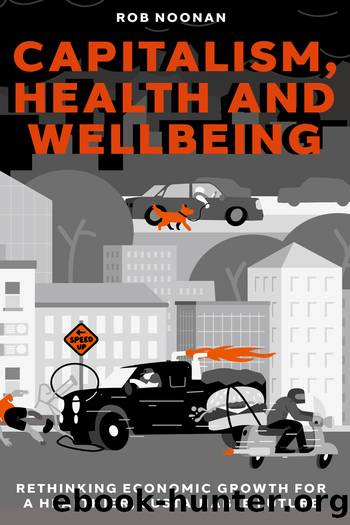Capitalism, Health and Wellbeing by Rob Noonan;

Author:Rob Noonan;
Language: eng
Format: epub
ISBN: 9781837978991
Publisher: Emerald Publishing
Published: 2024-02-14T00:00:00+00:00
Chapter 10
The Drive for Productivity Drives Physical Inactivity
Parents are told to turn off the TV and restrict video game time, but we hear little about what the kids should do physically during their non-electronic time. The usual suggestion is organized sports. But consider this: The obesity epidemic coincides with the greatest increase in organized children's sports in history.
Richard Louv, Lost Child in the Woods, 2010
Physical inactivity is among the most formidable public health challenges of our time.1 Not only is regular physical activity key to achieving and maintaining a healthy weight (alongside a balanced diet), it provides a range of psychological health benefits too. In the United Kingdom alone, physical inactivity is associated with 1 in 6 deaths and is estimated to cost the United Kingdom over £7 billion annually. The World Health Organization2 recently revealed that physical inactivity is on the rise, and predicted that globally, there will be around 500 million new cases of preventable non-communicable diseases between 2020 and 2030 if physical inactivity levels remain the same. But why? What's driving this formidable public health challenge? For decades, there have been a countless number of empirical studies, reports and news headlines like these informing us of the scale of physical inactivity â but not the underpinning reasons why. What's currently missing from this particular public debate is a recognition of the elephant in the room â economic growth. Therefore, in this chapter, I set out to illustrate how physical inactivity is in many ways an economic issue. I conclude by arguing that if the priority really is to address physical inactivity at the societal level then the metrics we use to define social progress will need recalibrating.
Incentives drive human behaviour. They always have done, and always will. Back in the hunter gatherer era, there was a need to undertake physical activity in order to survive. We needed to be able to move about to collect food and water, secure shelter and if needed â escape from predation. Fast forward a few thousand years to the Industrial Revolution. And again, being able to undertake physical activity on a daily basis was essential to getting by and surviving. Perhaps in a somewhat different way, but the logic remains the same. The Victorians didn't have the luxury of motorised forms of transport so they walked or biked around. There were no washing machines, dishwashers or vacuum cleaners â so there was no choice but to expend energy completing essential household chores. Work back then didn't entail being sat at a desk staring at a computer screen â it was full on physical graft.
Just like today, productivity was key to boosting company profits, so it was the most physically able â the fittest that were selected for work. They were selected because they were able to get more work done. The physically unfit were, therefore, at a great disadvantage. But as society has deindustrialised and become more of a knowledge and service-based economy, the necessity to undertake physical activity at work has gradually diminished.
Download
This site does not store any files on its server. We only index and link to content provided by other sites. Please contact the content providers to delete copyright contents if any and email us, we'll remove relevant links or contents immediately.
Spell It Out by David Crystal(35393)
Life for Me Ain't Been No Crystal Stair by Susan Sheehan(35181)
Cecilia; Or, Memoirs of an Heiress — Volume 1 by Fanny Burney(31438)
Cecilia; Or, Memoirs of an Heiress — Volume 3 by Fanny Burney(31033)
Cecilia; Or, Memoirs of an Heiress — Volume 2 by Fanny Burney(30980)
Professional Troublemaker by Luvvie Ajayi Jones(28995)
The Great Music City by Andrea Baker(22807)
We're Going to Need More Wine by Gabrielle Union(18121)
Twilight of the Idols With the Antichrist and Ecce Homo by Friedrich Nietzsche(17749)
The Secret History by Donna Tartt(16757)
Cat's cradle by Kurt Vonnegut(13951)
Bombshells: Glamour Girls of a Lifetime by Sullivan Steve(13156)
Pimp by Iceberg Slim(12992)
All the Missing Girls by Megan Miranda(12831)
Fifty Shades Freed by E L James(12487)
Talking to Strangers by Malcolm Gladwell(11980)
Norse Mythology by Gaiman Neil(11956)
The Social Justice Warrior Handbook by Lisa De Pasquale(11514)
Underground: A Human History of the Worlds Beneath Our Feet by Will Hunt(11305)
